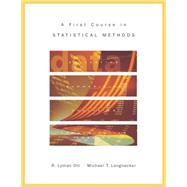- ISBN: 9780534408060 | 0534408060
- Cover: Hardcover
- Copyright: 7/30/2003
Step 1: DEFINING THE PROBLEM. 1. Statistics and the Scientific Method. Introduction. Why Study Statistics? Some Current Applications of Statistics. A Note to the Student. Staying Focused. Step 2: COLLECTING DATA. 2. Collecting Data Using Surveys and Scientific Studies. Introduction. Surveys. Sampling Designs for Surveys. Scientific Studies. Experimental Designs for Scientific Studies. Observational Studies. Data Management: Preparing Data for Summarization and Analysis (Optional). Staying Focused. Step 3: SUMMARIZING DATA. 3. Summarizing Data. Introduction. Calculators, Computers, and Software Systems. Summarizing Data on a Single Variable: Graphical Methods. Summarizing Data on a Single Variable: Measures of Central Tendency. Summarizing Data on a Single Variable: Measures of Variability. The Boxplot. Summarizing Data from More than One Variable. Encounters with Real Data. Staying Focused. 4. Probability and Probability Distributions. How Probability Can Be Used in Making Inferences. Finding the Probability of an Event. Basic Event Relations and Probability Laws. Conditional Probability and Independence. Bayes'' Formula. Variables: Discrete and Continuous. Probability Distributions for Discrete Random Variables. A Useful Discrete Random Variable: The Binomial. Probability Distributions for Continuous Random Variables. A Useful Continuous Random Variable: The Normal Distribution. Random Sampling. Sampling Distributions. Normal Approximation to the Binomial. MINITAB Instructions (Optional). Staying Focused. Step 4: ANALYZING DATA, INTERPRETING THE ANALYSES, AND COMMUNICATING THE RESULTS. 5. Inferences About Population Central Values. Introduction. Estimation of ì. Choosing the Sample Size for Estimating ì. A Statistical Test for ì. Choosing the Sample Size for Testing ì. The Level of Significance of a Statistical Test. Inferences about ì for Normal Population, ó Unknown. Inferences about Median. Encounters with Real Data. Staying Focused. 6. Inferences Comparing Two Population Central Values. Introduction. Inferences about ì1ì2: Independent Samples. A Nonparametric Alternative: The Wilcoxon Rank Sum Test. Inferences about ì1ì2: Paired Data. A Nonparametric Alternative: The Wilcoxon Signed-Rank Test. Choosing Sample Sizes for Inferences about ì1ì2. Encounters with Real Data. Staying Focused. 7. Inferences About Population Variances. Introduction. Estimation and Tests for a Population Variance. Estimation and Tests for Comparing Two Population Variances. Tests for Comparing t > 2 Population Variances. Encounters with Real Data. Staying Focused. 8. The Completely Randomized Design. Introduction. The Model for Observations in a Completely Randomized Design. Analyzing Data from a Completely Randomized Design: An Analysis of Variances. Checking on the AOV Conditions. A Nonparametric Alternative: The KruskalWallis Test. Multiple Comparisons. Encounters with Real Data. Staying Focused. 9. More Complicated Experimental Designs. Introduction. Randomized Complete Block Design. Latin Square Design. Factorial Treatment Structure in a Completely Randomized Design. Factorial Treatment Structure in a Randomized Complete Block Design.Estimation of Treatment Differences and Comparisons of Treatment Means. Encounters with Real Data. Staying Focused. 10. Categorical Data. Introduction. Inferences About a Population Proportion ð.Inferences About the Difference Between Two Population Proportions ð1 ð2. Inferences About Several Proportions: Chi-Square Goodness-of-Fit Test. Contingency Tables: Tests for Independence and Homogeneity. Odds and Odds Ratios. Encounters with Real Data. Staying Focused. 11. Linear Regression and Correlation. Introduction. Estimating Model Parameters. Inferences about Regression Parameters. Predicting New y Values Using Regression. Examining Lack of Fit in Linear Regression. The Inverse Regression Problem (Calibration). Correlation. Encounters with Real Data. Staying Focused. 12. Multiple Regression. Introduction. Estimating







